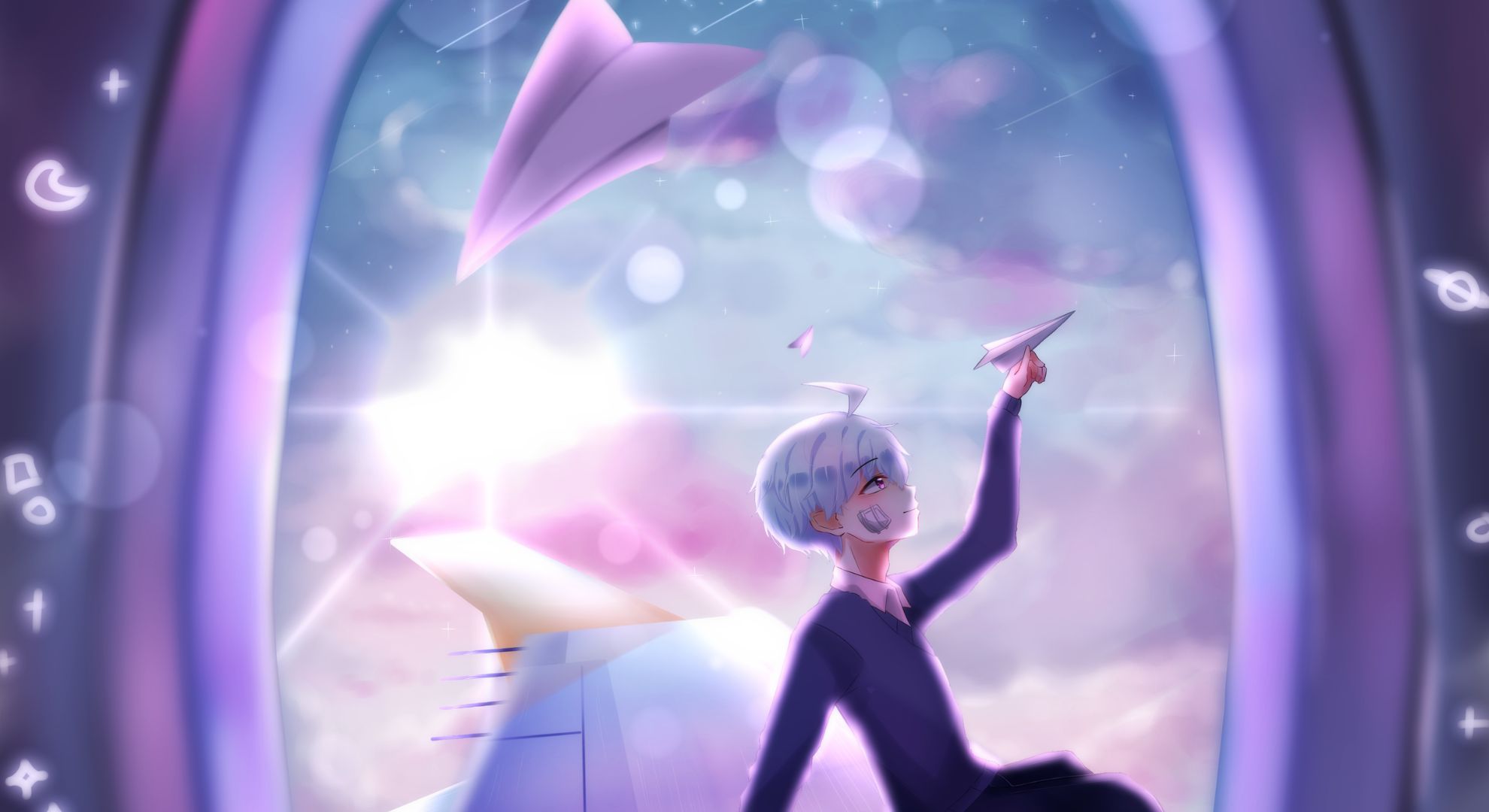The following #POPCreators entry was submitted by Hezekiah Louie R. Zaraspe, a language and literature teacher from Biñan, Laguna. He dedicates this piece to his father. Submissions under POP! Creator Community appears “as is,” without any editorial intervention.
***
If I were to do a sketch of the work, I would describe it thus:
Lounging on the left-wing of a plane, a young man is wearing a sweater over a shirt and dark trousers. His left hand is outstretched to launch a paper plane. Frozen mid-flight is another paper plane he launched beforehand. At ease, the young man basks under the sun’s warm, bright light, melding well with the bold yet gentle hues of the purple and indigo skies surrounding him.
I felt the energy of freedom and life from the picture.
It was beautiful. I had to stare and study the painting for a while.
“I wish she had given this a title,” I told myself. I felt as though the painting had to have something to say in words, but I quickly realized that it was enough on its own.
I taught Reading and Writing that semester. When the time came for the students to take their final exam, I allowed them to have virtually full rein over it. It was either a critique paper or a creative output, as long as what they wanted to do had some semblance to any topic we discussed in class, i.e., the essays we took up. Naturally, some students gravitated toward the latter. They may have been sickened by all the readings we had had to take up then, so I had no qualms with their choice.
Some wanted to write songs or original essays, while others wanted to draw comic strips. Dominique decided to paint. She was the only person in her class of STEM students to decide to do so.
When I asked everyone to bring all they needed for the task, she brought her laptop, a stylus, and a trackpad.
Strange, I thought. I had never seen an actual artist do a painting that way before, much less in front of me. When she did work on the picture, it was a thrill to watch her.
How could little movements of her fingers do so much on her virtual canvas? I often thought to myself. She was like a modern Basil Hallward, the painter from Oscar Wilde’s The Picture of Dorian Gray.
From afar, there was nothing magnanimous about her work. Nothing fancy. Nothing superfluous. When I started to study her work closely after a few days, I realized how much focus the work required of her, including the hand-eye coordination needed for it.
Unlike the usual canvases, easels, brushes, and paint that traditional artists use, she could not paint directly on her canvas. Instead, she had to have her eyes peeled on her PC’s screen while she guided her hands to use the stylus on her trackpad to digitally apply the paint.
It was an arduous, painstaking, and inconvenient task, it seemed to me. I wondered why Dominique was willing to do all of this for a final exam. She could have picked a more manageable task, something that was more doable and had little chance of failing; but, she looked adamant and determined to finish it. That was why I made no attempt to dissuade her otherwise.
Later on, I heard her make frequent, disdainful comments about it. Her face contorted whenever she had a mishap. Maybe the perfect images in her mind didn’t match what she managed to create during those short moments of frustration and anxiety.
What exists in the mind is perfect, after all. Everything else is subject to self-doubt, my mind thought. This idea is central in Plato’s Theory of Forms. The Greek philosopher would understand her struggle.
What I witnessed, though, betrayed her skill and ability.
Later on, I learned that she chose Jose Y. Dalisay’s essay, “With Windows Open,” as her inspiration. In it, Dalisay wrote:
“There’s something about rides that appeal to the Pinoy in a primal way: as a form of deliverance, perhaps, or transport in a more than physical—and almost spiritual sense.”
Perhaps what she thought of was an exodus of the spirit. Maybe she thought about the freedom that came along with that departure. But it didn’t matter to me if it was either or neither of these two. What mattered to me was the comfort and uplift I felt as I studied it.
On the day she emailed her final output to me, I was stunned. My mouth was half-open in awe. I remained seated in my chair. I smiled as it created and sustained a sense of serenity in me. When my words failed me, I let the picture speak to me instead.
She succeeded. The painting succeeded.
There is something ethereal yet concrete about paintings. What interests me the most is a painting’s ability to express an experience, feeling, or emotion that cannot be told using mere words—things that powerful strokes and streaks of color can only show and say. It must be why I find delight in the peace of Monet’s landscapes. It must be why I’m enthralled by the vibrance of life in Van Gogh’s pictures. It must be why I’m intrigued by the unsaid, unspoken words of the people in Amorsolo and Luna’s own masterpieces.
This I know clearly:
In sheer delight, the eyes lead the painting to the soul and the soul to the heart. You cannot help but just feel what you need to feel. Yes, you feel. We feel.
We feel and understand the gift of silence, its eloquence.
________
DISCLAIMER: All views and opinions expressed in this post are solely those of the contributor/s and do not represent those of POP! and INQUIRER.net. The POP! staff assumes no liability for any error in the content of this material. Got something you want to share to the world? Get a chance to publish your awesome creations and share it to the world through our POP! Creator Community program. Send us your stories, videos, photos, fan fic, and even fan art at pop@inquirer.net
For more details, read the POP! Creators FAQ page.
Follow us on Facebook and Twitter.
Other POP! stories you might like:
Navy’s spirits are lifted up once again as Rihanna makes her musical comeback
Here’s why it matters to call the Itaewon tragedy a ‘Crowd Crush’ and not a ‘Stampede’
10 books that turn 10 this year that might make you feel old



